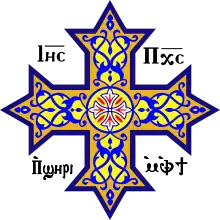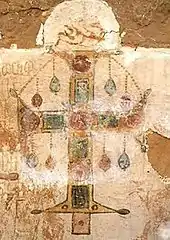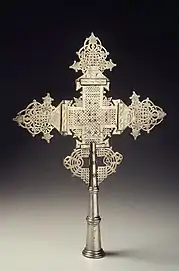
Coptic letters (Ⲓⲏ̅ⲥ̅ Ⲡⲭ̅ⲥ̅ Ⲡ̀ϣⲏⲣⲓ ⲙ̀ⲪϮ) are abbreviated nomina sacra for "Ⲓⲏⲥⲟⲩⲥ Ⲡⲓⲭ̀ⲣⲓⲥⲧⲟⲥ Ⲡ̀ϣⲏⲣⲓ ⲙ̀Ⲫ̀ⲛⲟⲩϯ" (Iêsous Piekhristos Epshêri Emefnouti; Jesus Christ, Son of God)
The Coptic cross is any of a number of Christian cross variants associated in some way with Coptic Christians.[2]
Typical form
The typical form of the "Coptic cross" used in the Coptic Church is made up of two bold lines of equal length that intersect at the middle at right angles. Each line terminates in three points, representing the Trinity of the Father, the Son, and the Holy Spirit. Altogether, the cross has 12 points symbolizing the Apostles, whose mission was to spread the Gospel message throughout the world.[3]
This form of Coptic cross is widely used in the Coptic church and the Ethiopian and Eritrean churches, and so this form of the cross may also be called the "Ethiopian cross" or "Axum cross". Bertran de la Farge dates it to the 4th century and cites it as a predecessor of the Occitan cross.[4]
History and variation
Old Coptic crosses often incorporate a circle,[5] as in the form called a "Coptic cross" by Rudolf Koch in his The Book of Signs (1933). Sometimes the arms of the cross extend through the circle (dividing it into four quadrants), as in the "Celtic cross".
In 1984, a modern variant of the Coptic Cross composed of three bars intersecting at right angles in three dimensions was given as a gift by the Coptic Orthodox Church and mounted on the top of the All Africa Conference of Churches building since the Coptic Church is considered to be the mother church in Africa.[6]
Popular culture
Many Copts have the cross tattooed as a sign of faith on the inside of their right arm at the wrist.[7]
One of the forms of the Coptic cross, which is referred to as the Ethiopian Coptic cross,[8] was worn by Stevie Ray Vaughan.[9] Keith Richards[10] also wears an Ethiopian Coptic Cross.
Gallery
 Illuminated early form of Coptic Cross at the end of the 4th–5th century Coptic Codex Glazier
Illuminated early form of Coptic Cross at the end of the 4th–5th century Coptic Codex Glazier 5th-century liturgical Coptic relief featuring the Coptic crux ansata
5th-century liturgical Coptic relief featuring the Coptic crux ansata Wall painting of a jewelled cross (Kellia, Egypt, late 6th century)
Wall painting of a jewelled cross (Kellia, Egypt, late 6th century) Coptic cross from the Ancient Egyptian Temple of Philae
Coptic cross from the Ancient Egyptian Temple of Philae Ethiopian Orthodox Processional cross from the Amhara Region (mid-20th century)
Ethiopian Orthodox Processional cross from the Amhara Region (mid-20th century) Coptic priest holding a hand-held blessing cross (Cairo, 2010)
Coptic priest holding a hand-held blessing cross (Cairo, 2010)
See also
References
- ↑ "Patriarcato Copto Cattolico – Home". 13 April 2014. Archived from the original on 13 April 2014.
{{cite web}}: CS1 maint: bot: original URL status unknown (link) - ↑ Liungman, Carl G. (2004). Symbols: Encyclopedia of Western Signs and Ideograms. Ionfox AB. p. 228. ISBN 9789197270502. Retrieved November 10, 2018.
- ↑ Goldman, Ari L. (1989-10-10). "Coptic Pope's Visit Cheers Faithful – The". New York Times. Retrieved 2011-01-02.
- ↑ "La croix occitane, dossier réalisé par O.Lamarque et C.Pujol, d'après un texte de Bertran de la Farge" (PDF). disciplines.ac-toulouse.fr (in French). n.d. Archived from the original (PDF) on 2016-10-11. Retrieved 2016-08-06.
- ↑ "The Coptic Cross". Seiyaku.com. Retrieved 2011-01-02.
- ↑ "Coptic Africa" (PDF). Archived from the original (PDF) on 2011-07-22. Retrieved 2011-01-02.
- ↑ "Deep Thoughts: Coptic Orthodox Tattoo". Mojoey.blogspot.com. 2005-01-19. Retrieved 2011-01-02.
- ↑ "Alternative Religions". Altreligion.about.com. Archived from the original on 2008-09-23. Retrieved 2011-01-02.
- ↑ "Stevie Cross". Stevieray.com. Retrieved 2011-01-02.
- ↑ "Keith Cross". ?. Retrieved 2012-01-21.
External links
